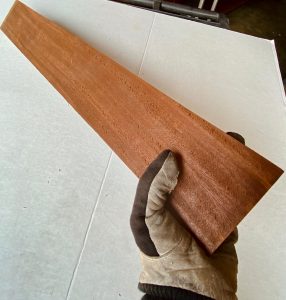Roasted Mahogany Lumber

Which Woods Are Roasted?
We bake Genuine and African wood. Between the two, Genuine (sometimes called Honduran) yields more consist results. Not surprisingly, Honduran is the more consistent wood in terms of both machining and appearance.
Additionally, we occasionally thermally treat mahogany substitute woods such as Okoume lumber, Sapele and Limba. Surprisingly, okoume wood roasts inconsistently. Despite its low density and uniform appearance, it is prone to kiln checking. This may be due in part to a high silica content.
What is Torrefied Mahogany?
The term torrefied wood refers to wood that has undergone a drying process. From Peter Schu with Dana Bourgeois: “Every acoustic guitar top must be dry, stiff and lightweight. For centuries, luthiers chased this holy trinity of adjectives with various methods of carving, bracing, and drying with air or kilns.
source: What is Torrefied Wood? (Lichty Guitars)
Mahogany is a straight-grained, reddish-brown timber of three tropical hardwood species of the genus Swietenia, indigenous to the Americas[1] and part of the pantropical chinaberry family, Meliaceae.
Additionally, the process is sometimes referred to as torrefaction.
Variations in kiln temperature and kiln time affect the wood color and machine-ability. For example, torrefaction is also used to make high energy wood fuel chips. Of course, tonewood requires much lighter roasting than wood chips!
Baked Mahogany Wood Color
One argument against roasted mahogany is that it does not significantly change the wood color. In my experience, this is accurate. Unlike baked maple, it is difficult to visually distinguish roasted mahogany from unroasted.
In the mid 2010’s, we baked 8/4 and 5/4 mahogany at a high temperature. Additionally, we left the wood in the kiln for a longer roast cycle. The result was a slightly darker roast color. However, the wood was brittle and checked, rendering it unusable.
It was an expensive experiment. However, it confirmed that baking mahogany wood to a darker color is not worth the risk.
Roasted Mahogany Guitar Wood: Benefits
A torrefied guitar body resist environmental changes. Not surprisingly, baked neck wood similarly resists re-acclimation.
However, there is one lesser known benefit to roasting mahogany. Thermally treating wood reduces the overall weight of the lumber. Primarily, this affects roasted mahogany body blanks.
The weight reduction is a direct function of the moisture lost during roasting. Thus, 8/4 Mahogany lumber goes into the roasting kiln at a moisture content of 8-10%. After torrifaction, the final moisture content may be 3-5%. Thus, less moisture in the wood results in less weight.
The lighter weight of the roasted mahogany wood is more significant in body wood than neck wood.


Pingback: ROASTED MAPLE: Torrefied Guitar Neck Wood Guide - Commercial Forest Products
Pingback: Good Genuine Mahogany🌳Where is it?Commercial Forest Products 2020
I really appreciate you for publishing this blog here about the tips for roasted mahogany wood; it’s really a helpful and very useful for us. This is really appreciated that you have presented this data over here, I love all the information shared. Great article!!
Thanks for reading!
Steve
Pingback: 10 Best Hardwoods For Woodworking By A Hardwood Lumber Pro - Commercial Forest Products